
Delhi, Thursday February 8, 1945. |
|
INITIAL CHINA CONVOY ARRIVES IN KUNMING Roundup Field Correspondent |
KUNMING, CHINA - Brig. Gen. Lewis A. Pick delivered the first convoy over the Ledo-Burma Roads, now known as Stilwell Highway, to the Chinese in Kunming this week, 23 days after leaving Ledo.
The tall, gray-haired builder of the Ledo Road personally led the convoy over the 1,050-mile route, a large portion of which fringed Jap held territory, without losing a piece of equipment. The General was the hero of the day in Kunming as he led his convoy through the West Gate in the city at noon today. All Kunming turned out for this historic occasion, A solid wall of humanity lined The Road from the West Gate four miles into the city proper, on through the city to SOS Headquarters, at the far side of the city, where the convoy was turned over to the Chinese.
The ride from the West gate, after Gen. Lung Yun, Governor of Yunnan Province and official representative for Generalissimo Chinag Kai-Shek, cut the ribbon officially opening the Stilwell Highway, was an experience no one on the convoy will ever forget.
The crowds were alive with color. Chinese, American, British and Russian flags fluttered on all
|
FROM SULTAN "When the first convoy over the Ledo-Burma route entered China a great goal was achieved. Every unit in the India-Burma Theater, Ground Forces, Air Forces and Service Forces, American, Chinese, British, India and Kachin troops, has made its contribution to that achievement. Your magnificient work has been hailed by all the United Nations and will long be remembered." |
The cool air of this 7,000-foot plateau was filled with the colored banners. Occasionally, Roman candles skyrocketed in the heavens. The smoke of burnt powder stung our eyes.
It was a polyglot crowd. Painted prostitutes jostled with merchants dressed in conservative American business suits. Coolies in rags crowded the curbs. Proud mothers and father held up tiny children above the crowd to see the convoy. Chinese boy and girl scouts, dressed in near blue uniforms, waved banners. Chinese women in fashionable fur coats and Western dresses mingled with women dressed in long, shapeless garments slit on the sides to their knees.
In the city, people clung to balconies and leaned out of windows. Flower peddlers swung their colorful wares high above the heads of onlookers. Rickshaw men stood by their rickety carts on the side streets and looked on with wondering eyes. And all along the way tha crowd grinned and chanted "ding how" as each vehicle passed slowly by down the stone streets.
Along the way but one person was seen oblivious to the occasion. A coolie woman in patched blue trousers and jacket was washing clothes in the canal which skirts the road on its way into the heart of the city. The firecrackers, the cheering, the blaze of color didn't disturb her for a moment as she industriously scrubbed her laundry in the murky waters of the canal.
Even the people in the riverboats which ply the canal had pulled their craft to shore and were joining in the festivities.
American drivers, colored and white, and Chinese drivers pushed the convoy carefully through the narrow lane of humanity which was held back by Chinese police of Kunming in gray uniforms and Chinese soldiers with long rifles and gleaming bayonets.
An official cermony at the West Gate preceded the parade through Kunming. And, before the ceremony began, Lily Pons, American opera star and her husband, Andre Kostelanetz, famous composer, both of whom are touring Army installations in China, Burma and India, were introduced to Pick.
NEW ROAD NAMED FOR GEN. STILWELL
Lung, the governor, speaking at the ceremony, told the crowd, "This is a happy occasion for China. The arrival of this first convoy marks the opening of this great new highway, just named the Stilwell Highway."
Pick, in turning the convoy over to the Chinese, declared, "One hundred yards away is the first convoy to penetrate the blockade of China in nearly three years. When the ribbon is cut China again will be linked with her allies by land communications.
"They said that the job of building this Road could not be done. But thousands of American Engineers, Chinese Engineers, and soldiers proved that it could. There stands the proof.
"You have arranged today's celebration in honor of personnel of the convoy. But the celebration should honor other men. It should be in honor of the soldiers and engineers buried in the jungles of Assam and Burma. It should be in honor of the Engineers who toiled and bled and fought to carve The Road through jungles and swamps - across mountains to the Burma Road.
"In opening this road we have to pay tribute to the man who had the vision to undertake its construction - General Joseph W. Stilwell.
"The building and opening of the Ledo Road to connect with the Burma Road fulfills another part of the pledge President Roosevelt made to Chiang Kai-shek to provide aid to China.
"It has been my privilege to command the troops that built the Ledo Road. Day and night they toiled through rain and mud, harassed by the pests of a tropical jungle, to carve this road through the Patkai mountains, past Chingto and the Chin Hills, across the Hukawng and Mogaung Valleys, over the Irrawaddy River past Bhamo to the Burma Road.
"The Ledo Road is the most important road in the world today. But there is an even more important road to be built. That is the road leading from the Ledo and Burma Roads to Japan proper. But before that can be built, supplies must be moved into China. Soldiers and construction men must have the equipment to push on. This convoy is but the first of the equipment to come over this road to prosecute the war against our common enemy, Japan."
Maj. Gen. Gilbert X. Cheeves, Commanding General of SOS in the China Theater, congratulated Pick and all of the men
 Meet Rita Daigle, who was chosen as queen of the Photographer's Ball held recently in New York City. Despite all the bulbs strung over her er-shoulders by art loving photogs, she doesn't look like a flash in the pan.
Meet Rita Daigle, who was chosen as queen of the Photographer's Ball held recently in New York City. Despite all the bulbs strung over her er-shoulders by art loving photogs, she doesn't look like a flash in the pan.
|
In the closing ceremony, Lung presented a silk banner to Pick. The banner was inscribed with Chinese characters, "Sung Li Che Lou." Translated this means "The Road to Victory."
The hardships of the past week are imprinted upon the faces of the men of the convoy today. The highest, longest mountain supply line in the world has been crossed; but the Himalayas have left their mark in wind-burned faces, lips and hands, cracked and bleeding from the cold, eyes weary and bloodshot from long hours on The Road.
People of the villages and towns greeted the convoy with gay displays of centuries-old pageantry. At the walled city of Paoshan thousands of persons lined the narrow stone streets, cheering, waving flags and banners, and firing long strings of firecrackers as we passed.
But despite the Paoshan welcome, the convoy was a serious business. On the morning of the second day out from Wanting the convoy was halted by an air raid alert at the bottom of the Salween Gorge, before crossing the long suspension bridge over the turbulent river.
It was a grim moment. Thirty-one Jap planes were reported in the vicinity. We were hemmed in by steep mountains on one side and the Salween River on the other - easy targets for strafing and bombing attacks. Gunners manned anti-aircraft machine guns mounted on the cabs of the trucks. The rest of the convoy personnel sought shelter on the rocky mountainside. But the alert proved to be false.
The walled city of Lungling was a blackened ruin. But its people had returned and were starting anew in its rubble. Sungshan Mountain was a battered monument overlooking the Burma Road.
The vehicles passed through many other ancient villages and towns. Yungping, Sichow, Siakwan, on the hillsides above Erhhai lake. Siakwan is a wind swept town at the foot of a snow-capped peak 13,000 feet high. The commercial center of Western Yunnan Province, it is the intersection of the Burma Road with caravan trails used by tea traders from Shunning to the south and Tibetan traders from the north.
Later the convoy passed through the open village of Yunnanyi and made its way slowly up Tienatze Miao Po (Temple of the Son of Heaven Mountain) to the highest point on the Burma Road, 9,200 feet elevation.
And, as the convoy neared its destination, it passed Hsachiao, Chennan and Tsuyung, an ancient Chinese walled city.
Stilwell's dream has come true and The Road named after him is now open from Ledo to Kunming.
 The two elephants above are four and five inches high - PX jobs. The scene is a spot about two feet square on the
bank of a stream at Myitkyina. The palms are about 10 inches tall and the logs one-half inch in diameter. The stage
setting by Maj. Perkins; photography by T/5 Carl Barmuta of an Engineer Aviation Battalion.
The two elephants above are four and five inches high - PX jobs. The scene is a spot about two feet square on the
bank of a stream at Myitkyina. The palms are about 10 inches tall and the logs one-half inch in diameter. The stage
setting by Maj. Perkins; photography by T/5 Carl Barmuta of an Engineer Aviation Battalion.
|
GEN. SULTAN'S HQ., BURMA - Days of communique silence in north Burma was broken at week's end when Northern Combat Area Command revealed details of an engagement in which the Mars Task Force captured a strongly defended hill from the Jpas about one mile west of the Burma Road near Mile 79. Casualties were reported heavy on both sides, with an estimated 200 to 250 Japs killed.
The captured hill had been occupied by the enemy since the Men of Mars moved in to establish their roadblock several weeks ago. Both forces were from within 100 to 200 yards from one another on opposite hills, but with draws between making it difficult for either to attack.
A few more similar Jap pockets remain along the hills west of the road between Mile 75 and 79. The enemy in this area has been firing rounds of 150mm and smaller artillery, some of which were knocked out during the Mars attack. Several large Jap artillery pieces are still shelling the American positions.
The Burma Road is now cleared from Mongyu, Mile 105, to Mile 80. At the same time the 38th Chinese Division moved east to Mongyu, other units of the 38th raced cross-country and started clearing up Jap pockets between Mongyu and the Mars roadblock. After the capture of Mongyu, the 38th units who invested the town moved south down the Burma Road and at Mile 60 joined the forces which had struck southeast. Heavy fighting occurred before the junction was effected and over 200 Jap bodies were counted.
ANOTHER YANK AIRFIELD FALLS IN JAP DRIVE
CHUNGKING (ANS) - A Japanese drive to close the remaining gaps in the Canton-Hankow Railroad resulted in the loss of still another base for the 14th Air Force, as Suichwan, east of the China-Indo-China corridor, was destroyed and abandoned.
The Japanese claim to have obtained full control of the 685-mile rail span from Canton to Hankow but this was denied by the new Chinese Army spokesman, Maj. Gen. Kung Chi-kuang. He said fighting was still in progress between Kukong and Chenhsien.
Kukong, which is the provisional capital of Kwangtung Province, has been lost to the Japanese. The city is an essential communications hub, 125 miles north of the Canton-Hankow Railroad.
The Chinese stated that the Japanese are deepening their zone of communication along the Eastern Coastal region and have driven within six miles of Fungshun, 45 miles northwest of Swatow, in anticipation of possible American landings.
In the meantime, Maj. Gen. A. C. Wedemeyer indicated the Japanese expected American landings on the China coast and said, "I assure you we won't disappoint them."
BRITISH ADVANCE ON MANDALAY
Three columns of the British 14th Army were threatening Mandalay, second city of Burma, this week.
One column drove from Monywa, 35 miles west of Mandalay, a second pushed east from Myinmu, 25 miles to the southwest, and a third threat developed from Singu, 40 miles to the north, where the British attacked in strength from a bridgehead across the Irrawaddy.
The British made another of their leap-frog landings off the western Burma coast, occupying the small island of Sagukyun, 120 miles east of Akyab. The landing was unopposed by the Japanese.
At Kangaw, site of an earlier amphibious operation, the 15th Indian Corps has seized the town, important as a communications center, and is beating off enemy attacks. Kangaw, less than a mile from the imporatant Myochaung-Taungup Highway, was strongly defended by the enemy, backed by artillery concentrations.
The Japs have been attempting to regain control of their escape route southwards from Myohaung and Minbya, throwing in strong counter-attacks.
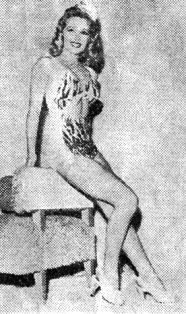 From an AACS unit at APO 493 comes this picture of Mary Elliott, Hollywood starlet, who maintains correspondence
with an old friend of civilian days stationed with the unit there. For reasons of his own he prefers to remain
anonymous. If her letters are as nice as her picture the sugar reports must be top-hole, rawther.
From an AACS unit at APO 493 comes this picture of Mary Elliott, Hollywood starlet, who maintains correspondence
with an old friend of civilian days stationed with the unit there. For reasons of his own he prefers to remain
anonymous. If her letters are as nice as her picture the sugar reports must be top-hole, rawther.
|
HQ., 14TH AIR FORCE, CHINA - It was an unusually light week for 14th Air Force fliers because of "non-operational weather" and non-cooperation from the Jap, who refused to offer opposition to most attacks.
Despite the bad weather, however, Maj. Gen. C. L. Chennault's airmen destroyed at least 10 enemy planes at Pailuchi and Yochow airdromes, sank one large freighter off Indo-China and destroyed eight locomotives on the Peibing-Hankow Railroad.
JAP AIR SCORE
WASHINGTON (ANS) - The Navy Department this week announced the following box score of aerial combat against the Japanese in the first three years of war: Japanese planes destroyed: 9,819; American planes lost: 1,882.
This showed a tally in our favor by the Navy and Marine pilots of about 26 to five. The figure included only planes shot down or destroyed on the ground, discounting those bagged by anti-aircraft fire.
EAC Raids Chumphon On Longest Mission
USAAF B-24's and RAF Liberators flew EAC's longest bombing mission this week in a 2,300-mile bomb flight against Chumphon, Japanese-held supply and shipping base on the Kra Isthmus.
The crews were in the air for 15 hours. When they left the target area the railway stations and trans-shipment sheds were ablaze, a bridge on the Singapore Railroad had been hit, the track had been torn at many points and railway cars were seen lying wrecked.
All the bombers returned safely. The Jap did not fire a single shot. Photographs show that the raid was a success.
EAC planes were also active in supporting the British drive around Kangaw, where the Japs were strongly entrenched. One height held by the enemy has been subjected to five continuous days of air attack.
Near Ramree, Spitfires were used as bombers in support of the ground offensive there.
THEATER SURGEON GETS CHINA ORDER
Theater Surgeon Col. Robert P. Williams has been awarded the Chinese decoration, Order of Yun Whei (Cloud Banner), in the First Grade of the Order, by Generalissimo Chiang Kai-shek in recognition of his work for the Chinese in Burma in 1942, and in training the Chinese Medical troops.
The award was presented by Maj. Gen. Frank Merrill, Deputy Theater Commander. Among the results of Williams' work have been establishment of Chinese Medical Training Schools and assignment of American medical officers to each Chinese Division.
The present Theater Surgeon was appointed when CBI was first organized.
YANK SUBMARINE PRESUMED LOST
WASHINGTON (UP) - The submarine Growler, from the deck of which her former skipper, Comdr. Howard Gilmore, gave the order, "Take her down," is listed as overdue and presumed lost, the Navy Department has announced.
The Growler figured in one of the epic incidents of the war more than a year ago. During a surface battle with a Jap gunboat, Gilmore was mortally wounded. Members of the crew tried to rescue him from the deck and carry him below, but the skipper, fearing rescue would take too long and endanger his ship, calmly ordered his own death warrant by saying, "Take her down!"
The crew obeyed and the Growler submerged to fight another day.
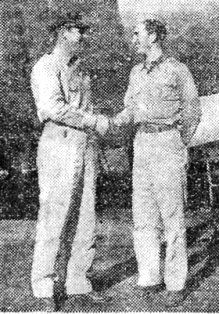 Capt. Jack C. Ledford, right, B-29 pilot, receives congratulations from his group commander, Col. William H. Blanchard,
upon receiving the Distinguished Service Cross. It is the highest combat award yet made to a member of the
XX Bomber Command.
Capt. Jack C. Ledford, right, B-29 pilot, receives congratulations from his group commander, Col. William H. Blanchard,
upon receiving the Distinguished Service Cross. It is the highest combat award yet made to a member of the
XX Bomber Command.
|
? XX BOMBER COMMAND
AWARDS DSC TO PILOT
XX BOMBER COMMAND, INDIA - The XX Bomber Command recently presented its highest combat award to date, the Distinguished Service Cross, to Capt. Jack C. Ledford for a heroic attempt to save the life of his dying flight engineer after Ledford himself had been wounded.
Ledford's courageous act was performed after the plane he was piloting had dropped its bombs over Omura, on Kyushu Island, and was attacked by Jap fighters.
Ledford had been badly wounded. M/Sgt. Harry C. Miller, flight engineer, had been wounded in the head. Ledford refused medical aid until the engineer had been treated. He handled the engineer's fuel transfer system for nearly an hour. Loss of blood forced him to stop. He then accepted aid but declined an opiate to keep his head clear.
When the loss of fuel caused abandonment of the ship, Ledford aided the crew in ripping open an extra parachute. The shroud lines were cut off. One end of them was attached to the navigator's table, the other to Miller's rip cord.
The unconcious engineer was dropped through the nose wheel well. The scheme worked. The static cord grew taut; the parachute blossomed open. Ledford then jumped but delayed opening his chute to be near Miller when he landed.
Despite the pilot's effort, Miller died shortly after he had been carried to an emergency hospital by Chinese soldiers. Ledford's wounds were treated and several days later he and his crew returned to their western China base. While recuperating in the hospital he received the Purple Heart.
Catholic Spokesman Attacks Cheesecake
WASHINGTON (ANS) - "Cheesecake pinup girls for Servicemen overseas provide an indecent picture before their dying gaze," said William C. Smith, assistant executive secretary of the National Council of Catholic men, which is having a conference at Catholic University this week.
Smith also said too many comics were teaching children the idea of "violence, crime and even lust." He criticized advertisements which "appeal to lower natures" including "lewd description" of women's undergarments.
PUBLIC RELATIONS OFFICE ALL-OUT ON COVERING JOURNEY TO CHINA; 'CANTEEN CARAVAN' GIVES SHOW
By S/Sgt. EDGAR LAYTHA Roundup Field Correspondent
MYITKYINA (Delayed) - The bivouac here before the first Indi-to-China convoy rolled towards Kunming was expected to last at least two weeks, but it left after a stopover of only eight days. During that hectic period, while we were waiting for Wanting and Namkham to fall, the entire war in Asia seemed to revolve around the little town of Myitkyina.
|
In these intermissions, enlisted men artists would jump out of their cars with pen and pencils to sketch the G.I.'s and the surrounding scenes. They were T/Sgt. James Zornes, well-known painter, Cpl. Ted Sally, Los Angeles cartoonist and Cpl. Sydney Kotler, commercial artist in New York. Sally did the personalities, Kotler the scenery, Zornes both. The output of the three will be sent to the States for distribution among newspapers. |
And there were the soldier-correspondents, three different radio teams, Gignal Corps photographers, War Department cameramen, official British and Chinese newsreelers and the representatives of the Office of War Information and the State Department.
The coming event was the climax of our activities in this part of the world. Gen. Joseph W. Stilwell's bold dream, carried out by Lt. Gen. Dan I. Sulatn, was soon to be attained. A land route from India to China was waiting for the first convoy.
The great event was celebrated by G.I.'s and generals alike. "The Canteen Caravan" of a Special Service company, gave a special jazz show in the convoy bivouac for the drivers.
The correspondents gave a Chinese dinner for the Public Relations people, and all were entertained by the Gens. Sultan, Howard C. Davidson and Lewis A. Pick on three different occasions.
All this happened during perpetual tension. The war at large was forgotten. Everybody waited anxiously for news from the front, which in this case was the Burma Road itself. Came the news of the fall of Namkham. At last Wanting fell. But The Road still had to be cleared of snipers.
When will the convoy roll - this was the eternal question. The harassed acting Public Relations officer of the India- Burma Theater, Lt. Col. Don C. Thompson, a gentleman from Harvard who was tired of the correspondents heckling, wrote a release in the manner of Gertrude Stein. It read, in part: "What are mountains? Mountains. What is mud? Mud. What are mountains and mud? A convoy is a convoy is a convoy is a pain in the neck."
At last, the convoy left Myitkyina the 23rd of January, a foggy Tuesday morning.
Statistics of WD Show Ledo Road Toughest Job
WASHINGTON (ANS) - The War Department this week backed up with statistics the proud boasts of G.I.'s who built the Ledo Road that theirs was "the toughest road construction job ever undertaken."
In an official release the follwing facts about The Road were disclosed: The 478-mile highway was built at a rate of about one mile per day through some of the worst jungle in the world and over 4,000-foot mountain passes. During one seven-month period, 175 inches of rain fell to hamper the work. By comparison, eastern States of the U.S. average less than 45 inches per year.
Approximately 70 acres of airstrips were built at points near the Ledo Road. The Road's builders moved a total of 13,500,000 cubic yards of earth. It would take a string of railroad cars 470 miles mong to transport the 1,303,000 cubic yards of gravel spread on The Road. To top it off, there's an average of one bridge to every three miles of The Road. So, take a well-deserved bow boys.
|
ASC SERVICE CHIEFS HIGH HONOR AWARD
Air Service Command has instituted the Service Chiefs award for men in this Theater who have done something outstanding in the line of duty to keep the planes flying. At right is S/Sgt. Edward R. Dillen of Cleveland, who displays part of the produce of his homemade foundry at an ASC base. Dillen experimented to find a mixture of sand and molasses to conquer the molding problems, which had been the chief bottleneck. He has improvised a foundry. Below left, M/Sgt. James Melvin Boyd of Kyman, Tex., suh, was among the first admitted to the Chiefs club. He is an electrical wizard credited with designing special tools and test equipment to keep the overhaul line from bogging down. Below right, M/Sgt. William W. Johnston of Pennsylvania can show the signature of his commanding general on a Chief card because of his designing and construction of weld assemblies. He used them to substitute for standard procedure in addition to tow construction bars, cranes, special jigs and fixtures. |
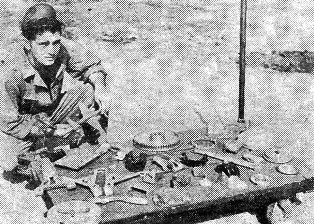
|

|
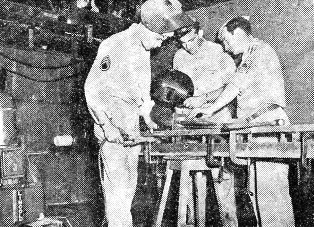
|
Long War In Pacific - Stilwell
NEW YORK (ANS-UP) - Gen. Joseph W. Stilwell, newly-appointed head of the Army Ground Forces, grimly stated this week that the war if the Pacific would not be won until long after Germany is defeated.
Speaking with his usual directness, the former CBI commander predicted the Japanese would soon be forced out of Burma, but warned they would continue to fight even after their home islands were conquered.
Stilwell forecast that the war would have to be fought out on the continent of Asia. He estimated that the Japanese are prepared to use 4,000,000 troops to defend their position on the Asiatic mainland. He said we have not even begun to cut into the Japanese reserves of manpower.
Touching on Burma, Stilwell stated the AAlies may reach Rangoon in a few months, with a stiff resistance awaiting them. "Japan can be expected to hang on at Rangoon as long as possible," he said. He pointed out that when Rangoon is taken more supplies could be moved to China over the old Burma Road.
Stilwell praised the Chinese soldier but acknowledged that he had criticized the performance of high Chinese officers.
"I've been accused of complaining about the capability of higher commanders," he said. "I have done that, but I believe many of them were handicapped because they didn't have what we consider essential training in junior grades. When they've had experience and training they perform very effectively."
"Uncle Joe's" credo in the CBI was always that there was one way to win the war and that was "to kill Japs." He ended his press conference on the same note.
"There's an excess 1,000,000 births over deaths in Japan yearly," he pointed out. "At that rate you have to kill 10,000 of them weekly to keep even."
CONVOY'S VIGNETTES AT BHAMO STOPOVER
BHAMO - (Delayed) - We in the first India-to-China convoy couldn't see much of Bhamo, as it was already dark when we moved in. It was our first complete field bivouac and the entire personnel stayed in for the night.
The jungle hammocks were slung between two rows of vehicles, then everybody settled down in front of his little gasoline stove, trying to transform his K-rations into a warm evening meal. The Chinese were fed by a regular field kitchen, the piece de resistance, of course, being rice.
The convoy's defense unit, an elite of Ramghar-trained Chinese soldiers, had its roll call, then one by one the men crept into their sacks.
But some stayed up late. Americans and a few Chinese officers who knew English gathered around the communications car and listened to the news of Josef Stalin's march upon Berlin. The convoy's two press censors offered their services to the correspondents for the entire night, but I think only Til Durdin, of the New York Times, filed copy about a roadblock Mars Task Force had established on the japanese escape route to Lashio. News about the convoy was taboo until we reached the China border.
As I lay in my hammock, I could listen to the conversations of the stay-up-lates. Every word, even when softly spoken, was clearly heard in the silence of the night.
S/Sgt. Robert B. Goodman, the driver of the lead truck and acting first sergeant of the convoy personnel, seemed very proud to drive the forst 6x6 into China. "It's quite an honor, I guess," I heard him say.
Two colored drivers were discussing a guy who offered them 1,000 Rupees if he could drive to China instead. The colored corporal who drove the jeep in which I was travelling was going to write his old farmer father a diary of the trip if censorship permits.
And so the men talked about small things and big things until there was silence all about.
Holds Three Stars, But Cow Stops Him
ATC BASE, ASSAM - Pfc. Otis Lee Dobyns wears three battle stars won in two theaters, but it took a sacred cow in India to cause him his first injury.
Dobyns served in Africa and Italy before coming to Assam, but now he wishes he'd never left Colorado. Driving a G.I. truck, he found a cow in his way. In an effort to spare the cow injury, he damaged the vehicle and ended up in the hospital here. His only consolation was a visit by Lily Pons and Andre Kostelanetz who stopped by during their recent tour.
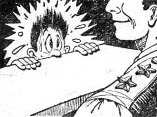
|
ATC BASE, INDIA - The PX wallah of the 1311th Base Unit will keep a future eye out for stray generals. Pfc. John Koralia is still furtively eyeing his single stripe after a recent encounter with a major general. Koralia was in his PX, back to the counter, and happily whistling when the general entered. Hearing the G.I.'s melody, the two-star wearer commented, "Well, I guess somebody's happy to be here in India." Koralia, without turning, responded, "Hell yes, I've found a home here. In fact, I've never had it so good." He then turned just in time to catch a glimpse of two stars and an outstretched hand, with a voice saying, "My name's C. R. Smith. What's yours?" Koralia's face has yet to resume its normal ruddy color.
SEVENTH PAYS HONOR TO GROUND CREWMEN
A BENGAL AIR BASE - The ground crews of the Seventh Bomb Group, a B-24 unit of the Allied Strategic Air Force, which operates in the India-Burma Theater under Maj. Gen. George E. Stratemeyer's Eastern Air Command, comes in for a lion's share of the credit for recent successes of the outfit in missions over Burma. There's not a combat flier in the outfit who wouldn't share his "fruit salad" decorations with the hard-working men who keep the big bombers in the air.
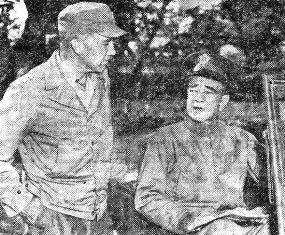 Maj. Gen. Howard C. Davidson (standing) commanding general of the 10th Air Force, received a compliment for the way
the combat ground troops had been supplied by planes of his unit from Lt. Gen. Dan I. Sultan India-Burma Theater
commander. This picture was taken at the Burma headquarters of the 10th. Sultan told Davidson that without the aid
of the 10th the success of the campaign to open The Road to China could not have been achieved.
Maj. Gen. Howard C. Davidson (standing) commanding general of the 10th Air Force, received a compliment for the way
the combat ground troops had been supplied by planes of his unit from Lt. Gen. Dan I. Sultan India-Burma Theater
commander. This picture was taken at the Burma headquarters of the 10th. Sultan told Davidson that without the aid
of the 10th the success of the campaign to open The Road to China could not have been achieved.
|
Maintenance records of the group have been repeatedly smashed during the past year, and the unit lays claim to the highest bomb group mark in the world. The Engineering Section, according to Capt. Anthony Bour, Engineering Officer, has a 91 percent maintenance record on the big Liberator bombers.
In paying tribute to the ground crews, Bour said, "Our exceptional maintenance of planes that are consistently being flown on some of the longest combat missions of the war is due in part to the fact that our maintenance crews are formed from a nucleus of veteran mechanics who recently completed their third year overseas."
The Seventh has been fighting the enemy from the air since the onset of the war. Early experience has given the group's mechanics invaluable knowledge in working under the field conditions prevalent in India three years ago.
Originally the outfit was called on to assemble P-40 and A-24 aircraft in Australia because of the lack of other trained personnel. After Java fell and the group arrived in India, the ground crews maintained a variety of planes, including Liberators, Mitchells and transports.
Stationed at the end of the supply line, the familiar improvisation of plane parts to keep a maximum of the then limited number of American planes in the air was the order of the day. The Seventh's handful of maintenance men at that time established a spirit that has been kept up by newcomers. Replacement ground men have become imbued with the tradition of good maintenance whaich was set up by the old timers.
There is a strong bond between the air and ground personnel of the Seventh. As one veteran pilot puts it, "To tell us that our ground crews aren't up to par is a sure way to meet a nurse in a hospital." The airmen have flown their planes on 15-hour missions over Thailand. They know that expert maintenance is responsible for the bombers bringing them back to India.
|
Thru G.I.'s In France
ATC BASE, BURMA - Good news came to a German-born G.I. here recently. The words of cheer came in the form of two V-mail letters from France to Pfc. Ernest Katz, a clerk in the orderly room at this base.
The letters were written by ETO soldiers Marvin Salzburg and Richard H. Arnold, who had met Katz's 21-year-old sister, Laurie, on separate occasions and wrote brief messages telling him that she was in fairly good health. To Katz it was the end of an eight-month period of worry.
Katz left Germany in 1936 with another sister and made his way to America. Two years later, another sister and brother followed, but their parents and youngest sister, Laurie, remained in Germany. In mid-October he received a telegram telling him that natives of his town had been sent to concentration camps in France.
Later, news came through that his mother had died due to malnutrition. Then came the invasion of North Africa in 1942 and an almost total eclipse of news from German occupied countries.
From then on, Katx communicated with his sister through Red Cross channels at six month intervals. Some friendly nuns sheltered her after she was released from the internment camp, and she found work as a child's nurse in Lyons.
At last came the invasion of France - and the welcome news from Salzburg and Arnold.
Strictly G.I. By Ehret
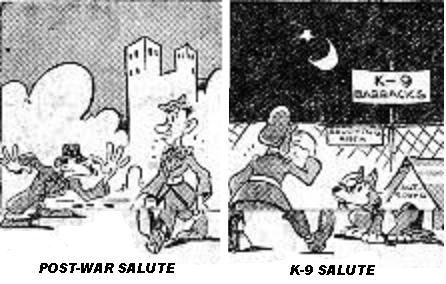

The Roundup is a weekly newspaper of the United States Forces, published by and for the men in Burma and India, from news and pictures supplied by staff members, soldier correspondents, United Press, OWI, and Army News Service. The Roundup is published Thursday of each week and is printed by The Statesman in New Delhi and Calcutta, India. Editorial matter should be sent directly to Capt. Floyd Walter, Hq., U.S.F., I.B.T., New Delhi, India, and should arrive not later than Sunday in order to be included in that week's issue. Pictures must arrive by Saturday and must be negatives or enlargements. Stories should contain full name and organization of sender. Complaints about circulation should be sent directly to Lt. S.R. Rose, Hq., U.S.F., I.B.T., New Delhi, India. Units on the mailing list should make notification of any major change in personnel strength or any change of APO.

FEBRUARY 8, 1945
Original issue of India-Burma Theater Roundup shared by CBI veteran Howard Sherman
Copyright © 2006 Carl Warren Weidenburner
TOP OF PAGE PRINT THIS PAGE ABOUT THIS PAGE SEND COMMENTS
PREVIOUS ISSUE CLOSE THIS WINDOW NEXT ISSUE
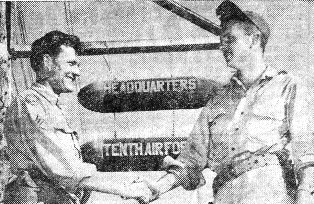 Lt. Charles I. Leonard, right, thanks T/Sgt. Carl W. Hughes after the latter rescued the officer who had been forced
down in the Burma jungle. Hughes, who was a staff sergeant when this picture was taken, rescued Leonard in a liaison
plane.
Lt. Charles I. Leonard, right, thanks T/Sgt. Carl W. Hughes after the latter rescued the officer who had been forced
down in the Burma jungle. Hughes, who was a staff sergeant when this picture was taken, rescued Leonard in a liaison
plane.